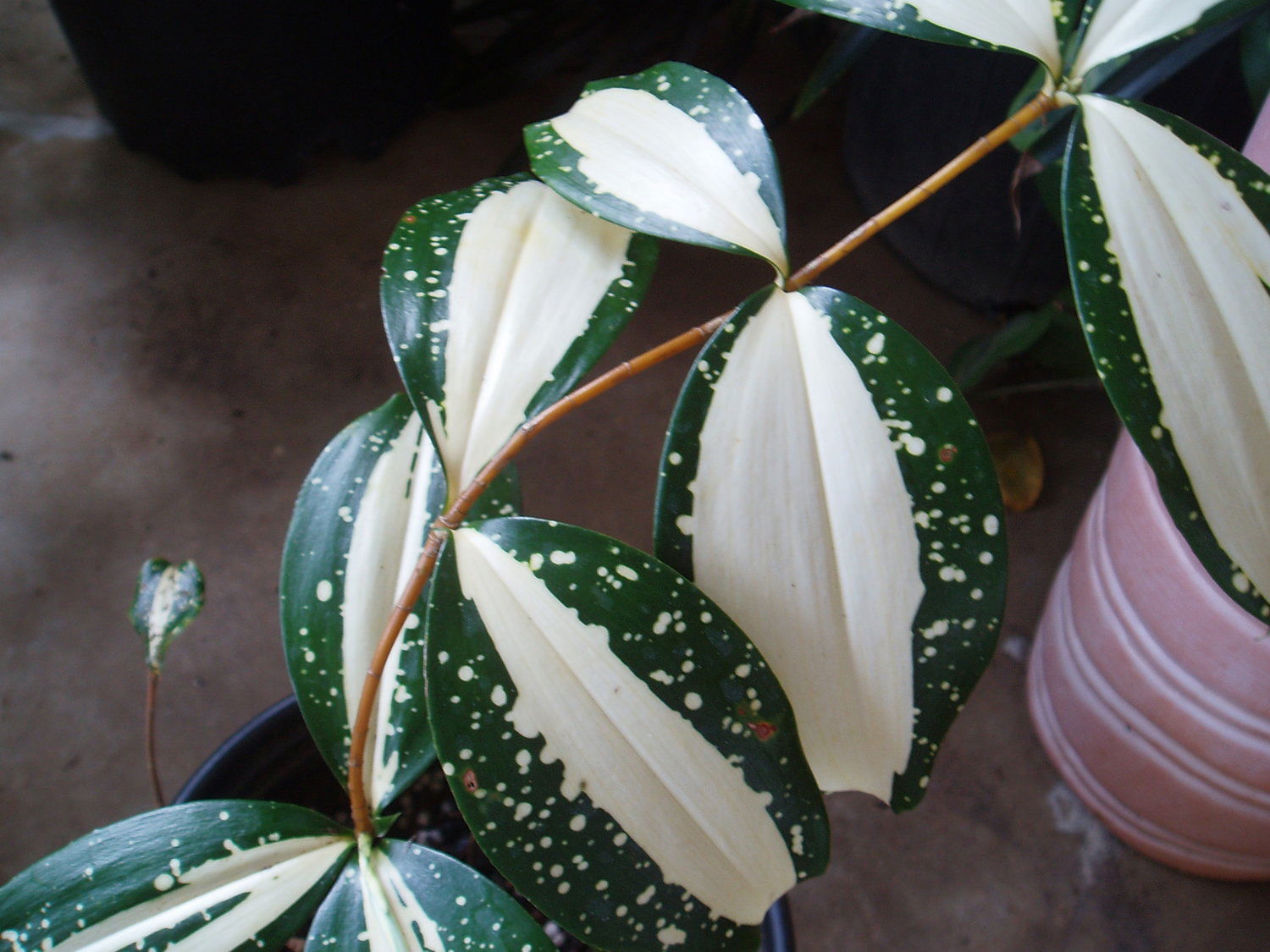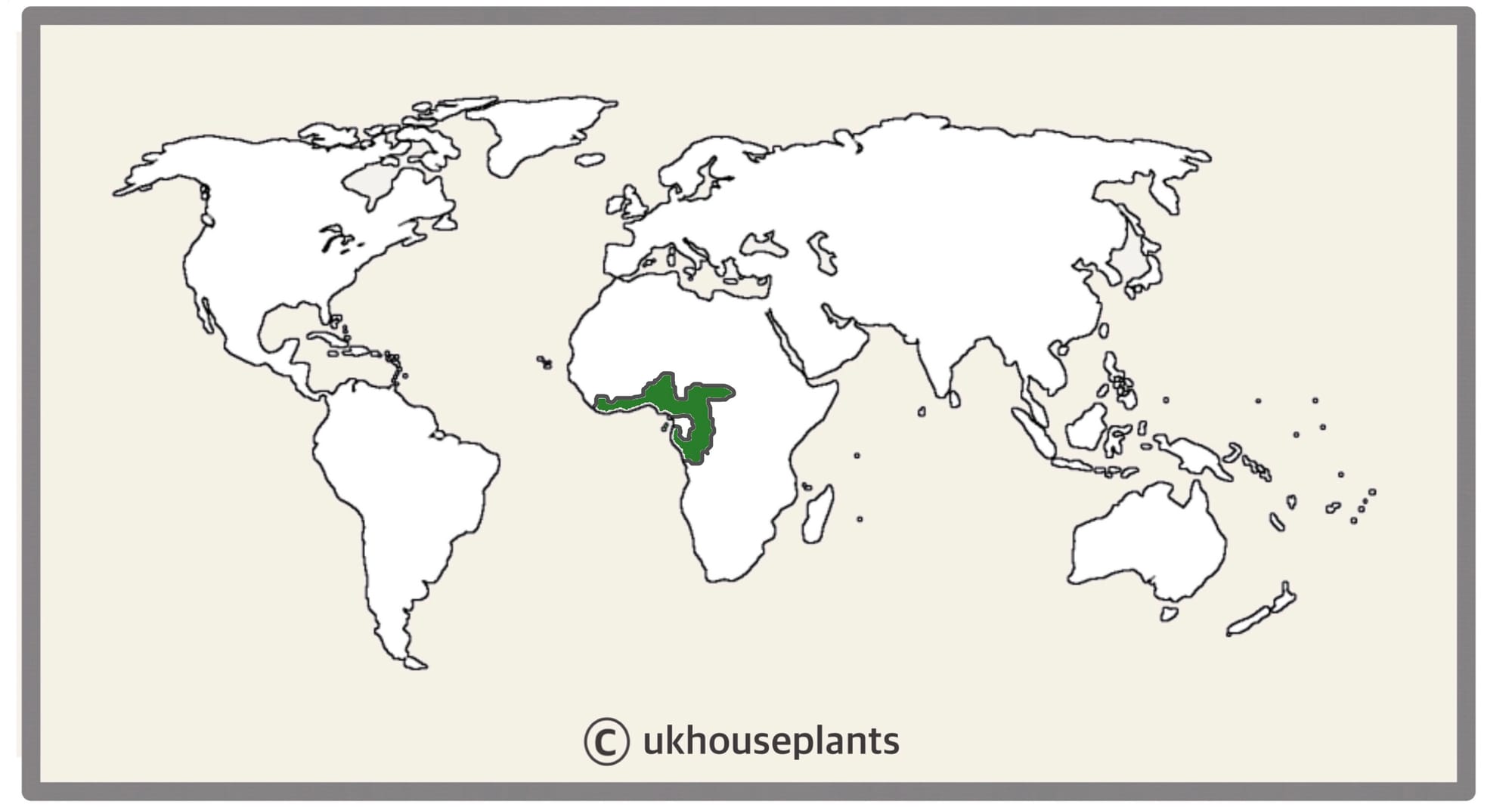
Dracaena surculosa var. maculata. Copyright: Crocus.co.uk.
Contents
- Top Tips
- Location, Water, Humidity & Fertilisation
- Common Issues
- Origins, Temperature, Propagation, Repotting & Toxicity.
Need the answer to a specific plant query? Book a 1-to-1 video call with THE HOUSEPLANT DOCTOR™, the website's friendly author, to overcome and address your niggling problem! Available on iMessage, WhatsApp, Facebook Messenger & more.
Top Tips & Info
- Care Difficulty - Moderate
- Present a bright, indirect location with the possibility of morning or evening sunlight. Because of the variegations, we'd advise not placing yours in a too dark of a location due to the risk of weakened health from lowered photosynthesis.
- Allow the soil's top third to dry out in between waters, reducing this slightly in the winter months.
- Fertilise using a 'Houseplant' labelled feed every four waters in the spring and summer, reducing this to every six in the colder months.
- Transplant every two years using a 'Houseplant' labelled compost and the next sized pot with adequate drainage holes. This is the perfect time to split the rhizomatous growths which will emerge from the plant's base, similar to pointed arrowheads. Scroll down to 'Propagation' to learn more.
Location & Light - 🔸🔸🔸
Situate your Japanese Bamboo in a bright location that offers an hour or two of off-peak sunlight (before 10am or after 4pm). Gentle exposure to the sun will not only reduce the risk of over-watering, but it'll also maintain the colourful variegations of its foliage. Due to its intolerance to low light, situations where a newspaper can’t be read without the use of artificial light, must be avoided if possible. We'd recommend situating your specimen in a north, east or west-facing windowsill, or within two metres of a south-facing window.
Water - 🔸🔸
As this species requires good levels of light, its soil will dry out rather quickly. Aim to water once the top third dries out, preventing the risk of dehydration. The combination of prolonged droughts and extended periods in direct light will result in sun-scorch and terminal damage to its leaves. Reduce waters slightly in the autumn and winter months to replicate its dormancy. Under-watering symptoms include a loss of older leaves, stunted growth, yellowed foliage and wilting. Over-watering symptoms include yellowed lower leaves, a rotten stem, and for severe cases, wilting with mouldy soil. For situations where its base or roots have become rotten, click on this link!
Humidity - 🔸🔸
Average room humidity is best. At monthly intervals, perform a gentle hose-down to hydrate its leaves and reduce the number of dust particles resting on its foliage. If you have an overly dry atmosphere indoors, we'd recommend introducing a pebble tray to increase the local humidity levels around the plant.
Fertilisation - 🔸🔸
Feed every four waters during the growing period and every six in the autumn and winter, using a 'Houseplant' labelled fertiliser. Never apply a 'Ready to Use’ product into the soil without a pre-water first, as it may burn the roots and lead to yellowed leaves.
 Dracaena surculosa 'Milky Way'. Copyright: Vintage Green Farms
Dracaena surculosa 'Milky Way'. Copyright: Vintage Green Farms
Common Issues with Japanese Bamboo
Curled leaves and dried brown edges are the result of too little water and over-exposure to the sun. Although Japanese Bamboo can naturally do well in partial sunlit locations, those that haven't acclimatised to the harsh rays will show signs of sun-scorch and environmental shock.
Root rot is a common issue among specimens sat in too dark environments with prolonged soil moisture. Symptoms include rapidly yellowing leaves, mouldy soil, stunted growth and a rotten brown base. Take the plant out of the pot and inspect health below the soil line. If the roots sport a yellow/grey tinge, you're good to go, but if they're brown and mushy, action must be taken immediately. If the symptoms are severe, split the rhizomatous growths into separate pots to impact their individual root systems. Learn more about addressing root rot on this link.
When Japanese Bamboo is severely dehydrated, most of its leaves will crisp-up and fall off - leaving you with a naked plant. Although it may spell the end of juvenile plantlets, there may still be light at the end of the tunnel for more established specimens. If its stem is still plump without any signs of retraction, prune-away the severely affected areas and provide evenly moist soi. Provide a good level of indirect light and temperatures above 15°C (59°F). After a few weeks, new life will form in the nodal junctions on the underground rhizomes, signalling the start of its recovery process.
Yellowing lower leaves could be the result of over-watering, too little light or nutrient deficiency. Allow the top half of the soil to dry out in between irrigations for the reduced chance of root rot. If the desired location is so dark that you can't even read a newspaper, it'll also be too shady for the plant. The last possibility could be to do with the lack of nutrients in the soil. If you haven't supplemented it in a while, it could be to do with nitrogen deficiency. This element is mobile within the plant, meaning that it can be moved to where the plant needs the most - i.e. the new growth. A lack of nitrogen in the lower leaves will result in the chlorosis, so it's vitally important to keep the soil nutrients topped-up.
A dark location (shelves, etc.) will promote the specimen to develop small or no juvenile leaves, giving the impression of 'leggy' or naked growth. The length between the nodes will also dramatically become larger, harvesting less energy that can be converted into sortable sugars. Be sure to increase the amount of indirect light somewhat, and give the specimen a gentle supplement of 'Houseplant' labelled feed to help with its stored energy.
Pests could arise with infestations starting from the original nursery or via contamination in your home. Spider Mites and Mealybugs to tend to be the usual inhabitants, with the first being minute and almost transparent, roaming the leaves in search of chlorophyll and a site to hide its eggs. The latter, however, will stand out much more, with white cottony webs developing across the foliage and stems. Thoroughly check the plant's cubbyholes before giving it the all-clear, or click on the appropriate links to learn more about eradicating these issues!
If your Japanese Bamboo develops basal collapse, it may spell the end of its life. The rhizomes, which are located below the soil line and act like a modified stem, is the lifeline for a successful specimen, so any issues of rot will kill it outright. If yours has problems of this, be sure to take the plant out of the pot and inspect its roots. Prune away any rotten areas and check its base for a softened profile. Remove any individual plants that have a rotten bottom and repot the healthy specimens in a fresh batch of 'Houseplant' compost. Provide a brighter location and reduce the number of waters slightly to avoid further rot. Discard the plant if there is no sign of health below the soil line.
Origins
John Lindley first described this species in 1828, using the specific epithet of 'surculosa', in reference to the 'sucker-like shoots' that poke through the soil. The species has natural distributions across central-west Africa, ranging from Gabon to Cameroon.
 The Distribution of Dracaena surculosa.
The Distribution of Dracaena surculosa.
Temperature
15° - 24°C (59° - 75°F)
H1b (Hardiness Zone 12) - Can be grown outdoors during the summer in a sheltered location with temperatures above 12℃ (54℉), but is fine to remain indoors, too. If you decide to bring this plant outdoors, don't allow it to endure any direct sunlight as it may result in sun-scorch and dehydration. Regularly keep an eye out for pests, especially when re-introducing it back indoors.
Spread
Up to 1.6m in height and 1m in width once they reach maturity. The ultimate height will take between 8 - 12 years to achieve, with several new basal growths per year.
Pruning & Maintenance
Remove yellow or dying leaves, and plant debris to encourage better-growing conditions. While pruning, always use clean scissors or shears to reduce the chance of bacterial and fungal diseases. Never cut through yellowed tissue as this may cause further damage in the likes of diseases or bacterial infections. Remember to make clean incisions as too-damaged wounds may shock the plant, causing weakened growth and a decline in health.
Propagation
Seed & Rhizomatous Division.
Rhizomatous Offset Division (Pups) (Easy) - Separating the basal offsets into their own pot will not only expand your plant collection, but it'll also slow the process of becoming pot bound. The best time to divide is during the spring or summer, with the pup's height surpassing 8cm with several mature leaves. Gently brush away some of the soil to gain better access to the pup's base (lower stem) where the roots will be housed. While using a clean pair of secateurs or scissors, cut the stem with at least two root strands attached to its base. Set the pup in an appropriate-sized pot with adequate drainage and a 'Houseplant' labelled compost. The ideal location would provide bright, indirect light and temperatures above 15℃ (59℉). Maintain evenly moist soil, allowing the top third to dry out in between hydrations. After a month or two, treat it like a matured specimen by using the care tips mentioned above!
Flowers
Small, pompom-like white flowers are arranged along a thick flower shaft that'll appear horizontally towards the top half of the stem, lasting several weeks. It's highly unlikely that a domestically grown specimen will bloom indoors due to the unfavored growing conditions of too low humidity and consistent temperature levels throughout the year.
Repotting
Repot every two years in the spring, using a 'Houseplant' labelled compost and the next sized pot with adequate drainage. Hydrate the plant 24hrs before tinkering with the roots to prevent the risk of transplant shock. For those that are situated in a darker location, add a thin layer of small grit in the pot's base to improve drainage and downplay over-watering. Click here for a detailed step-by-step guide on transplantation, or via this link to learn about repotting with root rot.
Book a 1-to-1 video call with THE HOUSEPLANT DOCTOR™ if you'd like a personal guide to repotting your houseplant. This will include recommending the right branded-compost and pot size, followed by a live video call whilst you transplant the specimen for step-by-step guidance and answer any further questions!
Pests & Diseases
Keep an eye out for mealybugs, aphids, spider mites, whitefly, blackfly & vine weevils that'll locate themselves in the cubbyholes and undersides of the leaves, with the exception of the latter in soil. Common diseases associated with Japanese Bamboo are root rot, leaf-spot disease, botrytis, rust, powdery or downy mildew & southern blight - click here to learn more about these issues.
Toxicity
This plant is classified as poisonous. If parts of the plants are eaten, vomiting, nausea and a loss of appetite could occur. Consumption of large quantities must be dealt with quickly - acquire medical assistance for further information.
Retail Locations
Online Stores.
Book a 1-to-1 Call with THE HOUSEPLANT DOCTOR™
If you need further advice with your houseplants, book an advice call with ukhouseplants' friendly and expert writer today! This can be done via a video or audio call on most apps, including Facebook, FaceTime & Skype. A ten-minute call costs £5.99 (US$7), or £15.99 for thirty minutes. You can ask multiple questions, including queries on plants, pests, terrariums, repotting advice and anything in between. Please consider supporting this service to keep ukhouseplants thriving!